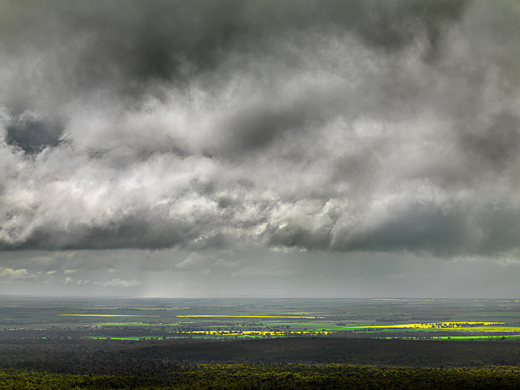 Falling Skies No 4, Pigment Print, 127 x 170cm, 2011
Falling Skies No 4, Pigment Print, 127 x 170cm, 2011
The world is often in far too much turmoil in front of the lens for me to also be in turmoil behind the lens. I therefore privilege the stillness of my camera as a welcome respite, and because I respect the extraordinary optical purity of my lenses I do all I can to stabilise them. I use devices like my surveyor’s tripod with geared heads, or when I’m the sole camera support a hand held gyro stabiliser. I have used these same devices for over 30 years; faithful companions in the quest for optical revelations on sensitive surfaces.
My lenses, that so carefully draw the world for me, when combined with the joy of working at the limits of a diffraction limited system, teach me the principles of stillness and stability. This condition can not be taken for granted, because technique can also destroy optical purity long before diffraction defines its limits. If the camera is not perfectly still during exposure another factor, instability, takes over the determination of how the picture is drawn. An unstable camera robs our finest lenses, while stability, whether it comes through technique or technology respects their democracy and the complex projections lenses undertake on our behalf. As a lens reflects the world it also contemplates what we are doing, and this conversation consciously and deliberately becomes embedded in our process. Technique therefore is the forging of technology with ideas, desires and emotions. Lenses that extend our vision; techniques that extend our grasp; and thoughts, words and gestures that extend our intellectual appreciation both reveal and make good the latency in photographic practice.
The careful inspection of my images below at 100% magnification reveals my Hasselblad H4D-200MS camera and lenses becoming diffraction limited around f12 to f13. This is why, except when movement is more important than resolution, I rarely use a smaller aperture than f11, often f8, before stacking multiple planes of precise focus in post production.
The physics of diffraction for circular apertures also confirm my visual findings, where:
A = 2 (1.22 λ F)
A = diameter of the bright central spot of an airy disk (m)
λ = wavelength of light (550 x 10-9 m)
F = f stop
Given the sensor’s pixel pitch we can calculate when the diameter of the airy disk, that point of optical uncertainty at a given f stop will exceed the resolution of the sensor thereby diffraction limiting its resolution. Nyquist’s sampling theorem infers that twice the pixel pitch, that is a before and an after, is required to define a point, which also defines the minimum circle of confusion for that system. A bayer filter array also interpolates the chromatic resolution across a grid of 2 x 2 pixels where green light is sampled at twice the frequency of red or blue light. Diffraction limiting will therefore be visible at 100% screen magnification when the airy disk exceeds a 2 X 2 pixel grid on the sensor. My Hasselblad H4D-200MS system has a pixel size of 6 microns, therefore the diagonal of a 2 X 2 pixel grid is 16.97 microns. Beyond this diameter an airy disk will be increasingly noticeable as an unsharp and unresolved point. The following airy disks (in microns) are calculated for my system:
f 16 = 21.47
f 14 = 18.79
f13 = 17.45
f 12 = 16.10
f 11 = 14.76
f 8 = 10.74
Given an f stop is a constant (the ratio of aperture to focal length) and that all my Hasselblad lenses can resolve beyond their sensor’s pixel limit, the system’s diffraction limit is independent of the lens.
Art and science being the twin conditions of our contemporary consciousness; the believable and the believed, enlightenment myths of place, acquisition and occurrence, and the ignorance of pejorative skepticism, all too often conspire against learning what our ways and processes have to teach us. Maybe we just have to learn to trust that the materials we are working with will, in their own time give us confidence to make another image, and to trust that our work means something, and that what we are really doing is creating such connections between people and things. Our gestures, actions and processes are our allies because they work together, because they belong together, and because they transcend the doubts and blockages that consciously besiege our will. It is about knowing what to do, and why it looks after us.


{ 0 comments… add one now }